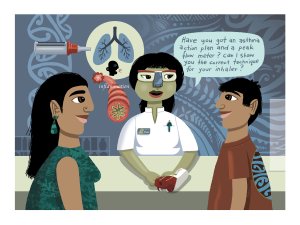Academic pharmacist Nataly Martini discusses the medical management of asthma in adults and adolescents, which has evolved to prioritise early anti-inflammatory treatment. She also explains how to improve patient outcomes by proactively identifying poor asthma control and supporting equitable access to education and treatment
Pain meds not effective for treating osteoarthritis
Pain meds not effective for treating osteoarthritis

Pharmacists can help patients with osteoarthritis pain as part of allied health teams, expert tells Paulette Crowley
As waiting lists soar for people needing elective orthopaedic surgery, experts believe there should be more allied health teams that include pharmacists to keep people out of operating rooms.
According to the New Zealand Orthopaedic Association, there are around 6600 New Zealanders waiting for elective surgeries for hip and knee replacements and spinal surgery, with many having osteoarthritis (OA).
In May, the Government set up a taskforce to tackle the problem but with staff shortages and the pandemic, the lists could take years to clear with more people being added all the time.
Clinical guidelines promote conservative treatment of OA – pain management, physiotherapy, exercise and weight loss – but University of Otago researcher Haxby Abbott told Pharmacy Today that has been ineffective, with people often ending up having surgery before all other options are exhausted.
Professor Abbott says joint replacement surgery is suitable only for people with severe OA, with less than 20 per cent of people with knee or hip OA needing it.
He says the problem with implementing intervention programmes for osteoarthritis is that they are not available in all primary-care settings across the public health system, apart from a few initiated by “progressive” DHBs in Canterbury and Bay of Plenty.
The Ministry of Health reports it has a range of 15 mobility action programmes across the country, which include a mix of digital and in-person programmes.
Professor Abbott’s research in the Management of Arthritis Trial (MOA) suggests that physiotherapy interventions reduce pain and disability in patients with OA, and may delay or prevent need for surgery.
He explains it’s important to start OA programmes as early as possible.
“These interventions delay deterioration of the joint and help to heal it.”
However, the extent of reversing the pathology of OA is limited to mostly in the early stages of disease.
He says he is concerned the current taskforce takes a short-term approach to managing the problem of waitlists, with no allied health professionals involved.
“A longer-term system-wide approach preventing lists happening in the first place is essential and that solution lies in primary allied health care.”
From 2019/20, Tend Health pharmacist Katrina Azer worked on a physiotherapist-led OA prevention programme at Longhurst Health in Christchurch.
The programme, which was initially privately funded through the centre and later received DHB funding, found that patient mobility and pain improved, and was maintained two years later when measured again.
“They also had better mental health, which was a secondary outcome of the programme,” says Ms Azer.
She says the patients’ quality of life also dramatically improved because they were no longer isolated and lonely, and could be more social and active outside of their homes.
Her role in managing pain mainly focused on reducing medication to manage OA.
She says best practice chronic pain guidelines from overseas recommend the first line of treatment is exercise and cognitive behaviour therapy-based mindfulness to reduce stress.
NSAIDs have weak evidence to support that they effectively manage OA pain but may be used sparingly due to risks of stomach ulceration, drug interactions. However, they can be briefly used to manage OA flares, she says.
There is also little evidence that paracetamol – “which GPs give to patients in great big boxes” – is effective for resolving the management of OA.
“But this is the number one prescribed intervention.”
Ms Azer says there needs to be better education for GPs in helping their OA patients manage their condition effectively.
“There needs to be a paradigm shift in treating OA.”
We're publishing this article as a FREE READ so it is FREE to read and EASY to share more widely. Please support us and the hard work of our journalists by clicking here and subscribing to our publication and website






